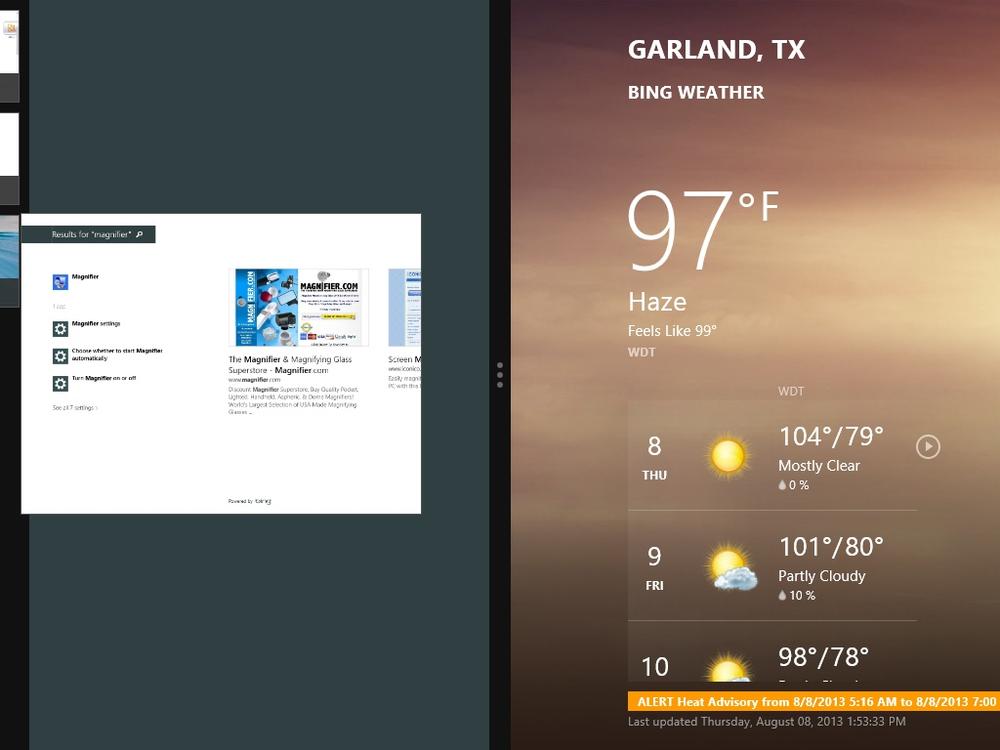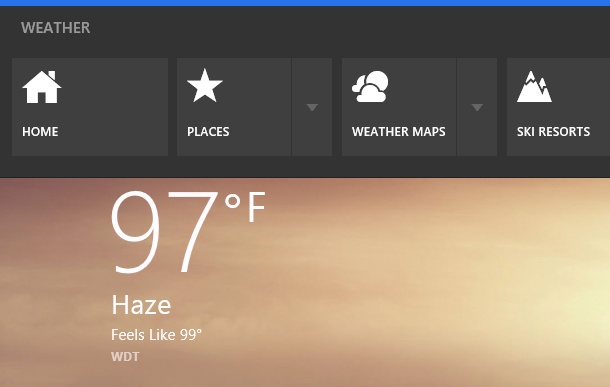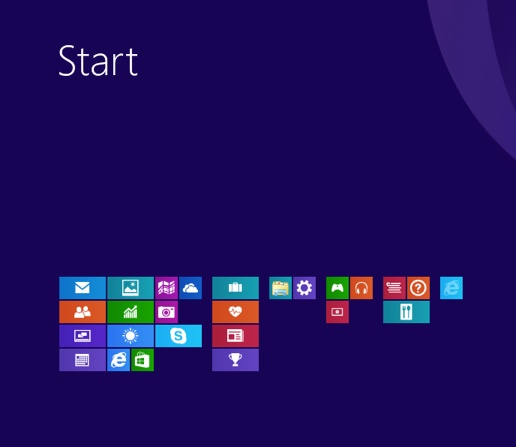IN THIS APPENDIX, YOU WILL LEARN HOW TO
As long as there have been Windows operating systems, there have been keyboard shortcuts. You might know some already. You might even know that you can press the Windows key to return to the Start screen from anywhere in Windows 8.1, for instance, or that Windows key+C displays the default charms. There are many more shortcuts; you will likely be surprised at just how many there are and the extent to which you can use them.
In this appendix, you’ll first learn the keyboard shortcuts that work in Windows 8.1 and how to experiment with touch keyboard shortcuts. Then, you’ll see the touch gestures you can use in Windows 8.1 when running it on a computer or device with touch capabilities.
Practice Files
You do not need any practice files for this Appendix. A complete list of practice files is provided in the section “Using the practice files” in the Introduction of this book.
Some keyboard shortcuts are unique to Windows 8.1, such as pressing the Windows key to return to the Start screen, mentioned earlier. Some keyboard shortcuts are traditional, such as using Ctrl+x to delete selected text, Ctrl+z to undo what you’ve just done (perhaps restoring text you’ve just deleted), and so on. These have been around for decades and almost always produce the same results.
Tip
See Chapter 17 for more information about personalizing the keyboard to use Sticky Keys, Toggle Keys, Filter Keys, Mouse Keys, and so on.
The following list contains a few keyboard shortcuts that are extremely useful in Windows 8.1, and you can use most of them no matter where you are (in an app, on the desktop, using Internet Explorer, and so on) on the computer.
Tip
If you prefer the On-Screen Keyboard to a traditional keyboard, you can use these shortcuts there. However, because you can’t hold down two keys at the same time, click the first required key (such as the Windows key) and then the second (such as D or C).
Access the Start screen. Press the Windows key
Access the desktop. Windows key+D
Show the Charms. Windows key+C. Shortcuts for the charms are:
Search. Windows key+Q or just start typing when you are on the Start menu
Share. Windows key+H
Start screen. Press the Windows key
Devices. Windows key+K
Settings. Windows key+I
Show the app bar while in any app. Windows key+Z
Cycle through open apps. Windows key+Tab or Alt+Tab
Zoom in and out. Ctrl+– to zoom out and Ctrl++ to zoom in
Tip
You’ll find that many of the traditional shortcuts you’ve always used still exist, such as Windows key+L to lock and Windows key+P to project to another display.
The following is a list of common keyboard shortcuts that you can use in Windows 8.1:
Windows key. Opens the Start screen.
Right Shift key. If you press it for eight seconds, it turns on Filter Keys. If you press it five times in a row, it turns on Sticky Keys.
Ctrl+mouse wheel. This changes the size of things. When used on the desktop in an app like WordPad, it changes the view. When used on the Start screen, it zooms in and out. When used in some apps, it zooms or scrolls.
Ctrl+A. Select all.
Windows key+C. Open the charms.
Ctrl+C. Copy selected text or items.
Windows key+D. Show the desktop.
Alt+D. Select the address bar in Internet Explorer.
Windows key+E. Open File Explorer.
Ctrl+E. Select the search box in File Explorer.
Windows key+F. Show Files in the Search charm.
Windows key+Ctrl+F. Open the Find Computers window, which can find computers on a network (used mostly in business networks).
Windows key+H. Open the Share charm.
Windows key+I. Open the Settings charm.
Windows key+J. Switch the focus between snapped apps and larger apps.
Windows key+K. Open the Devices charm.
Windows key+L. Lock the computer and display the lock screen.
Windows key+M. Minimize all the windows on the desktop.
Ctrl+N. Open a new File Explorer window.
Ctrl+Shift+N. Create a new folder in File Explorer.
Windows key+P. Open the project options for a second screen.
Windows key+Q. Open the Search charm.
Windows key+R. Open the Run window.
Ctrl+R. Refresh the screen.
Windows key+T. Set the focus on the taskbar and cycle through the running desktop apps.
Windows key+U. Start the Ease of Access Center.
Ctrl+V. Paste.
Windows key+W. Open Settings in the search charm.
Windows key+X. Open the WinX menu.
Ctrl+X. Cut.
Ctrl+Y. Redo (only works after using Ctrl+Z to undo something)
Windows key+Z. Opens the app bar. It works only in Windows 8-based apps.
Ctrl+Z. Undo.
Windows key+keys from 1 to 9. Display the app at the given position on the taskbar.
Windows key++ (plus sign). Zoom in while using the Magnifier tool, Internet Explorer and in some other instances.
Windows key+– (minus sign). Zoom out while using the Magnifier tool, Internet Explorer, and some other instances.
Windows key+, (comma). Peek at the desktop.
Windows key+Enter. Start Narrator.
Windows key+Alt+Enter. Start Windows Media Center if installed.
Alt+Enter. Open the Properties window for the item selected in File Explorer.
Space. Select or clear an active check box (but not a check mark that appears on a selected item on a touch screen, like a folder).
Tab. Move forward through options.
Windows key+Tab. Cycle through Windows 8.1 app history.
Alt+Tab. Switch between opened apps (including desktop apps).
Shift+Tab. Move backward through options.
Esc. Cancel.
Ctrl+Esc. Show the Start screen.
Ctrl+Shift+Esc. Start Task Manager.
PrtScn. Copy an image of your screen to the Clipboard.
Left Alt+Left Shift+PrtScn. Turn on High Contrast.
NumLock. Press for five seconds to turn on Toggle Keys.
Windows key+PageUp. Move the Start screen to the left monitor.
Windows key+PageDown. Move the Start screen to the right monitor.
Left arrow. Open the previous menu or close the current submenu.
Windows key+Left arrow. Snap the active desktop window to the left.
Windows key+Shift+Left arrow. Snap the active desktop window to the left monitor.
Ctrl+Left arrow. Show the previous word or element.
Alt+Left arrow. Show the previous folder in File Explorer.
Right arrow. Open the next menu or submenu.
Windows key+Right arrow. Snap the active desktop window to the right.
Windows key+Shift+Right arrow. Snap the active desktop window to the right monitor.
Ctrl+Right arrow. Show the next word or element.
Ctrl+Shift+Right arrow. Select a block of text from the current cursor position to the right.
Windows key+Up arrow. Maximize the active desktop window.
Windows key+Shift+Up arrow. Maximize the active desktop window and keep the current width.
Alt+Up arrow. Advance up one level in File Explorer.
Windows key+Down arrow. Minimize the active desktop window.
F1. Display Help if available.
Windows key+F1. Start Windows Help and Support.
F2. Rename the selected item.
F3. Search for a file or folder.
F4. Display items in the active list (works only for desktop apps).
Ctrl+F4. Close the active document.
Alt+F4. Close the active item or app.
F5. Refresh.
If you have a touch-based device, you can use the touch keyboard. It’s available on the desktop taskbar by clicking the keyboard icon. You can then use it to type in any compatible app.
On the right side of the touch keyboard, there are several icons that you can tap to configure the keyboard to display in different ways. In the illustration that follows, a traditional keyboard is selected, but it’s easy to see the others. If you don’t like the traditional keyboard, you can select the split keyboard. You can also write with a pen in the designated writing area and hide the keyboard when you no longer need it.
You can also configure how you want the touch keyboard to work. On the Start screen, type keyboard. In the search results area, select Ease Of Access Keyboard Settings, and then choose the option to change.
You can make changes to how you type from the Typing tab in PC Settings. From the Settings charm, click Change PC Settings, click PC And Devices, and then click Typing.
You might want to make note of the following options in particular:
Add A Period After I Double-Tap The Spacebar
Capitalize The First Letter Of Each Sentence
Play Key Sounds As I Type
You can use Windows 8.1 on a multitude of touch-based input devices such as tablets, compatible monitors, laptops with trackpad gesture support, and so on. Before using Windows 8.1 on such devices on a daily basis, becoming thoroughly familiar with the touch gestures and their mouse equivalents will quickly make you more productive.
The touch gestures you can use in Windows 8.1 are the following (the mouse equivalents are presented after each one).
Access the Search, Share, Start, Devices, and Settings charms
Snap apps
Touch gesture. Swipe from the left edge to swipe in the last used app. If you swipe quickly, the app will fill the entire screen. If you swipe slowly, you can snap the app to take up only part of the screen.
Mouse equivalent. Place the mouse in the upper-left corner and slide down the left side of the screen to see the most recently used apps. Click to select one for fullscreen viewing or drag it inward slowly to snap it.
Open an app
View app commands
Close an app
Touch gesture. Drag an app down from the top to close it. You don’t have to close apps. They won’t slow down your computer or device, and they’ll close on their own if you don’t use them for a while. If you want to close an app, drag the app to the bottom of the screen.
Mouse equivalent. Click the top of the app and drag it to the bottom of the screen.
See details about an item
Touch gesture. Press and hold to learn more about an item, or to copy, paste, and to perform other tasks that are dependent on the item being held. You can almost always see details when you press and hold an item, as shown here. In some cases, pressing and holding opens a menu with more options.
Mouse equivalent. Point to an item to see more options; if nothing happens, right-click the item. You will likely have to click Properties after you right-click.
Perform an action
Pan and scroll
Touch gesture. Slide to drag. This is used mostly to pan or scroll through lists and pages, but you can use it for other interactions, such as moving an object or drawing and writing.
Mouse equivalent. Click, hold, and drag to pan or scroll. In addition, when you use a mouse and keyboard, a scroll bar appears at the bottom of the screen so you can scroll horizontally. You might be able to use your mouse wheel to scroll.
Zoom in and out
Touch gesture. Pinch or stretch to zoom. Zooming provides a way to jump to the beginning, the end, or a specific location within a list. You can start zooming by pinching or stretching two fingers on the screen. You can pinch on the Start screen to zoom in and out on app tiles.
Mouse and keyboard equivalent. Hold down the Control key on the keyboard while using the mouse wheel to expand or shrink an item or tile on the screen.
Rotate an item
You can use keyboard shortcuts to navigate in Windows 8.1 just as you could in previous versions of Windows.
If you have a touch screen, you can use the touch keyboard to type text, including keyboard shortcuts you would use on a physical keyboard.
Learn the touch gestures Windows 8.1 supports if you plan to use it and be productive on a device with touch input.










